The Case of the Missing Fuel: The story of the Stockport air disaster
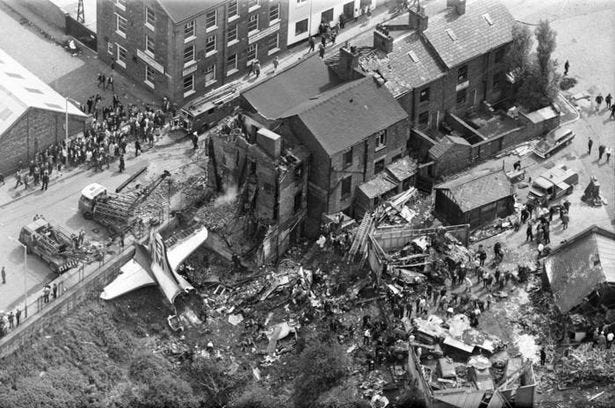
On the 4th of June 1967, a deadly drama unfolded in the skies over England as an antiquated propeller airliner lost two of its four engines on approach to Manchester. As the pilots fought to keep their crippled Canadair Argonaut airborne, they found themselves losing altitude and on a collision course with the densely populated town of Stockport. With nowhere to land and barely any control of their plane, all they could do was put it down and hope for the best. The outcome proved catastrophic, as the plane slammed into several buildings and a wooded ravine, breaking into pieces and catching fire as it plowed through the center of downtown. Although bystanders miraculously escaped harm, the passengers and crew of British Midland flight 542 were not so lucky: of the 84 on board, only 12 would survive, pulled from the wreckage by first responders before fire consumed the plane.
Investigators were faced with a puzzling accident scenario. Two engines had clearly failed, but there was nothing mechanically wrong with either of them, and the plane should have had plenty of fuel. It would be months before they discovered the existence of a hidden flaw in the design of the airplane which set the disastrous sequence of events in motion, a flaw which could cause an engine to fail due to but a few millimeters’ difference in the position of a cockpit lever. It was a problem that had perplexed pilots, misled engineers, and been misidentified or ignored for years, a quirk that underscored the vigilance required when flying an obsolete airplane from an era with less stringent safety standards.
◊◊◊
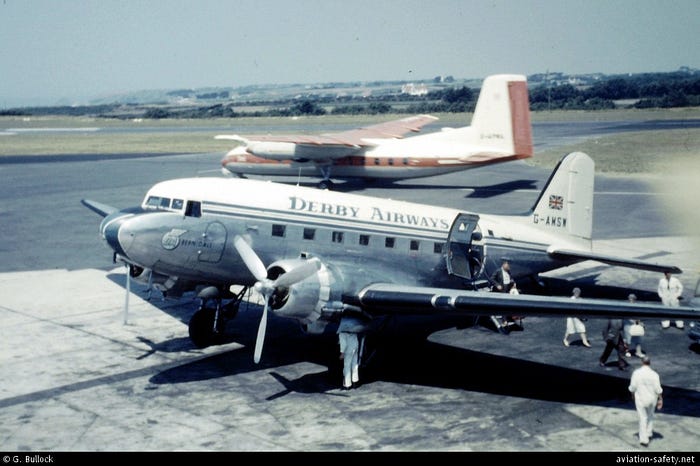
In 1953, a former flight school in Birmingham, England decided to become a scheduled airline, and the company that would later be known as British Midland Airways was born. Although it ceased operations in 2012, the airline was at its peak the third largest in the United Kingdom, having risen from its humble origins with a single Douglas DC-3, to operating wide body aircraft on intercontinental routes to Africa, America, and Asia. But to tell the story of the airline’s deadliest day, one must look toward the beginning of its history — to 1967, in the dying days of the piston era, when the airliners of the 1940s still plied the skies of Europe, albeit in rapidly dwindling numbers.
At that time, British Midland Airways operated a wide variety of aircraft, among them three examples of the Canadair C-4 Argonaut. The Argonaut was, in essence, a Douglas DC-4 whose four Pratt & Whitney engines had been replaced with British-made Rolls Royce Merlin engines instead, among a few other changes designed to improve its performance. This upgrade of the DC-4 was originally undertaken by Canadian manufacturer Canadair at the request of Trans-Canada Airlines, and 71 examples were ultimately produced between 1946 and 1950. The model, officially known only as the Canadair 4, was also called the North Star, while 22 examples delivered to the British Overseas Airways Corporation became known as C-4 Argonauts, although there was no significant difference between the Argonaut and the North Star. Originally designed for 55 passengers, BOAC’s Argonauts were later fitted with significantly more seats, and when British Midland Airways acquired some of them second-hand in the early 1960s, they further expanded the passenger capacity to 78.
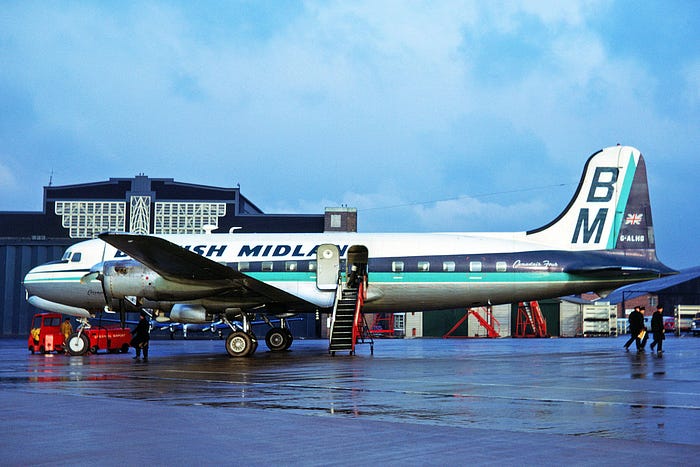
British Midland used its Argonauts to fly tourist charters to European holiday destinations, a lucrative market that still drives a large share of Britain’s airline industry to this day. One of the most common destinations was Palma de Mallorca, a beautiful seaside city in Spain’s Balearic Islands.
One of the Argonauts, registered as G-ALHG (callsign “Hotel Golf”), arrived in Palma de Mallorca early on the 4th of June 1967 to pick up a full load of tourists headed back home to Manchester, England. The charter, designated flight 542, would be under the command of 41-year-old Captain Harry Marlow, an experienced pilot with 10,000 flying hours, and his rookie first officer, 21-year-old Christopher Pollard, who had started flying at age 18 and seemed to have a bright career ahead of him. They were joined that day by two flight attendants, a ground engineer, and 79 passengers — enough to fill all 78 seats, plus one extra, an infant.

Once all 84 passengers and crew were aboard and the plane fueled up for the journey, flight 542 departed Palma de Mallorca at 6:06 a.m. local time (4:06 a.m. UTC). The next several hours passed uneventfully, as the plane cruised without trouble over France and across the English Channel. Shortly before 9:00 UTC (10:00 local time, used hereafter), the flight began its approach to Manchester’s Ringway Airport and prepared to lock on to the instrument landing system.
It was at around this time — approximately 10:01 — that the number four engine, the outermost on the right wing, abruptly ceased operation. Fifteen seconds later, the number three engine next to it also stopped generating power.
Almost immediately, the plane became extremely difficult to control. Captain Marlow found that the Argonaut had gained an overwhelming desire to pull to the right, which could only be countered by positioning the rudder as far to the left as it would go. Struggling to deal with the sudden emergency, Marlow radioed air traffic control and said, “Hotel Golf is overshooting, we’ve got a little bit of trouble with RPM.”
By overshooting — known today as going around, or executing a missed approach — Marlow intended to abandon the approach, climb to a safe altitude, and sort out the engine problems before trying again. In accordance with this decision, he took over control from First Officer Pollard, broke off to the right, and prepared to circle back around to the beginning of the approach procedure.
Simultaneously, the controller instructed the crew to turn left and climb to 2,500 feet, as was standard practice when overshooting on this runway. He then asked why flight 542 was overshooting, to which Marlow again replied, “We’ve a little bit of trouble with RPM, will advise you.”
In fact, this was a case of classic British understatement, considering the dire situation with which the pilots were now confronted. Flight 542 was turning right not because Marlow wanted to disobey the controller’s instructions, but because the plane simply could not turn left. At the same time, the tremendous drag from the two failed engines and the overall reduction in available thrust made it impossible for the aircraft to maintain level flight, let alone climb. From an altitude of just 1,600 feet, flight 542 began to drop, slowly and inexorably, toward the ground.

Having already turned back, Captain Marlow and First Officer Pollard now had no choice to but to complete their 360-degree loop if they wanted to return to the approach path. And if they were to make it to the runway, they would need to find some way to level off. But the laws of physics had sided against them. If they leveled off, the plane’s speed would begin to drop alarmingly, and if they let it get too low, they would surely experience a deadly VMC roll.
The term VMC, or minimum control speed, refers to the lowest speed at which directional control of the airplane is possible with one or more failed engines on the same side. The authority of the flight controls decreases at lower speeds; hence, below some particular velocity, which would be VMC, the rudder will no longer be able to counteract the yaw induced by the asymmetric thrust from the engines even at full deflection. Should the speed of the airplane drop below VMC, the aircraft will yaw heavily into the failed engine or engines, followed seconds later by an uncontrollable roll and spin into the ground.
Marlow and Pollard were thus faced with a terrifying catch-22: if they tried to level off and proceed toward the runway, the drag on the right wing would cause the plane to decelerate continuously until it reached VMC and went out of control. The only way to keep the speed above VMC was to convert potential energy into kinetic energy by descending, but to descend fast enough to avoid losing speed would see them fly into the ground well short of the runway. Thus, whether they knew it or not, flight 542 was already doomed.

Coming around the back side of the loop, the plane had dropped below 1,000 feet and was still descending. Alarmed by the flight’s low altitude, the controller initiated the emergency response protocol, and the airport firefighters scrambled to get ready for a possible crash landing. At the same time, he asked the crew of flight 542 whether they could maintain altitude, to which Captain Marlow replied, “just about.”
But it was a false hope. Passing through 400 feet above the ground, the Argonaut dropped off the controller’s radar screen; elsewhere, witnesses looked on in alarm as the plane flew low and slow over populated neighborhoods, clearly struggling to maintain height. Its airspeed was just 105 knots, barely above VMC, and falling.
Captain Marlow was now faced with a nightmare scenario. His plane was going down and a crash landing was inevitable, but there was nowhere to put it: they were over the town of Stockport with just seconds to pick a landing site, and everywhere he looked, there were buildings, crowded around the narrow, winding streets. The plane was heading straight for the town center, where thousands of people lived and worked, most of them unaware that a crippled airliner was about to crash down on top of them. Disaster was plainly inevitable.
At a height of about 200 feet above the ground, they ran out of time. The plane, traveling dangerously slowly, lost lift, stalled, and fell abruptly from the sky, plummeting to the ground in a matter of seconds. The left wing struck a three-story residential building and was sheared off, partially collapsing several flats in the process, while the rest of the plane continued just 15 meters farther on, where it slammed into the edge of a wooded ravine and a garage atop it, flattening most of the building and leaving the tail section protruding out into space over the edge of a retaining wall.
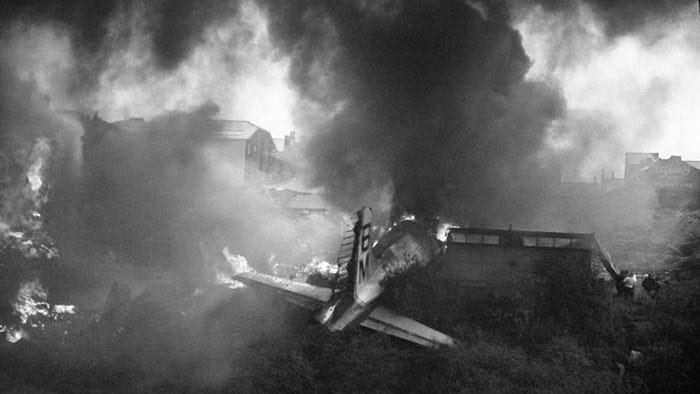
Although it was not moving very fast, the plane came to an extremely abrupt halt, subjecting the passengers to a momentary deceleration in excess of 9 G’s. This brutal impact ripped all the seats out of their mountings and sent the rows collapsing forward like a concertina, hurling dozens of people and seats into a horrific logjam near the front of the airplane. The deceleration and subsequent crush killed a number of people outright, but many others survived, nearly all of them seriously injured; in particular, metal reinforcement bars across the backs of the seats caused horrific leg injuries to the passengers behind them, leaving survivors trapped and unable to exit the plane under their own power. And to make matters worse, a number of fires had been ignited by the impact, and if they spread to the fuel tanks, even those who had survived the crash faced the prospect of burning alive.
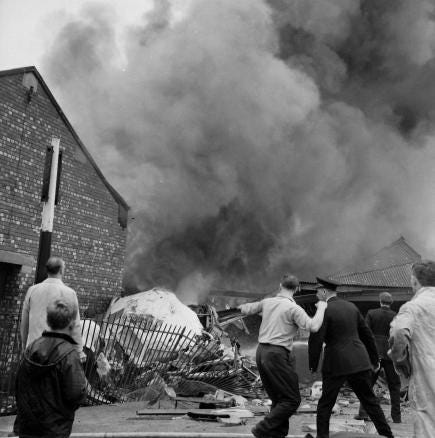
Miraculously, the aircraft had managed to thread the needle between the Stockport Town Hall, the Stockport Infirmary, the Stockport Police Station, and several tall blocks of flats, all of which were located just a stone’s throw from the crash site. At the police station, located less than 100 meters from the site of the accident, officers heard an enormous bang and ran to the scene, some of them reaching the plane within seconds. Upon arriving, they made a horrific discovery: through a break in the forward fuselage, they could clearly see a massive tangle of dead and injured passengers, many of them pinned in their dislodged seat rows, all of them unable to escape. Officers and random civilians, braving the scattered flames and smell of aviation fuel, hurried to pull them out, one at a time.
Despite the massive rush to help, it proved difficult to extract the trapped passengers. In ten minutes they managed to pull out ten seriously injured survivors and a number of dead bodies, but at that moment one of the plane’s fuel tanks exploded, forcing the rescuers to flee. Moments later, the fire overran the mangled remains of the passenger cabin, and those still trapped inside were burned alive, even as firefighters fought to douse the flames.
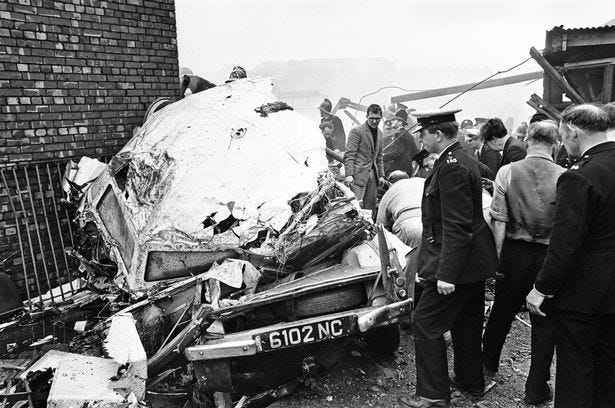
However, the cockpit, which came to rest up against the wall of the garage, crushing a car, was not involved in the fire, and here rescuers continued their desperate efforts. After cutting their way through the debris, they managed to pull Captain Marlow alive from the wreckage, followed shortly thereafter by First Officer Pollard. Although both were rushed to hospital, doctors declared Pollard dead upon his arrival. Captain Marlow survived with a blow to the head and a broken jaw, although he had to be put under heavy sedation. Also found alive was stewardess Julia Partleton, who was thrown clear of the plane on impact and escaped both the mess inside the cabin and the ensuing fire. Unfortunately, most were not so lucky: of the 84 on board, only Partleton, Marlow, and the ten rescued passengers would survive, while the remaining 72 passengers and crew perished in the crash and the inferno which followed.

By the time the flames had been extinguished, several buildings had been destroyed, including the garage, and little remained of the plane save for the tail, the cockpit, and the tips of the wings. Remarkably, however, no one on the ground was injured, an outcome which was heralded as a miracle in news reports across the country. Although it was widely speculated at the time that Captain Marlow purposefully brought the plane down in the best possible spot, the evidence for this is scant, and the absence of any people at the point of impact was more likely a coincidence. Unfortunately, Marlow himself could not provide any input on this question, or for that matter any other, because the blow to his head left him unable to remember anything about the last part of the flight.
◊◊◊
In 1967, Britain did not investigate accidents in the same way as most countries do today; instead of the Accident Investigation Branch (AIB, today AAIB) taking full responsibility, this agency was but one party to a public inquiry headed by the Board of Trade, which at that time regulated a number of transportation sectors, alongside the Air Registration Board (ARB).
Composed of representatives from the Board of Trade, the AIB, the ARB, British Midland Airways, Canadair, and other interested parties, the investigation team arrived at the scene shortly after the accident, slipping behind a police cordon which had been set up to hold back a crowd of an estimated ten thousand curious onlookers. By this point they already knew that the captain had reported a problem with at least one of the Argonaut’s four engines. However, when the engines were transported to manufacturer Rolls Royce for a teardown, they found nothing mechanically wrong with any of them. Nevertheless, the number four propeller clearly was not spinning at the time of the crash, and in fact it had been feathered — its blades angled edge-on into the wind — to improve its aerodynamics after the engine ceased generating power.
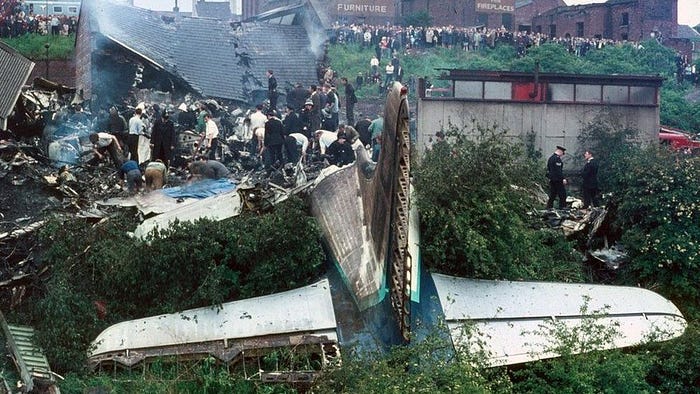
The airplane’s primitive flight data recorder, which recorded four parameters onto a reel of tape, provided a further clue. By combining the aircraft’s speed and altitude readings during the last nine minutes of the flight, investigators were able to show that the plane continuously lost energy until it simply fell to the ground and came to a stop. Calculations also showed that the only way for its energy state to degrade at that particular rate was if two engines had failed, one of which was feathered, and one of which was not. And finally, the rudder trim, which biases the rudder in a particular direction, was found set to the fully left position, which would only be necessary if both failed engines were on the same side of the airplane. That meant that engine three also must have failed, but that the pilots never feathered its propeller, causing it to “windmill” in the oncoming airstream, which resulted in significant adverse drag.
A series of flight tests proved that in such a state the aircraft was extremely difficult to fly. In 1967, four-engine aircraft were required to handle reasonably well with two engines out, even on the same side, but the Argonaut was designed in 1946, before such stringent standards existed. Should such an event happen on the Argonaut, maintaining altitude would be impossible in any scenario, and the pilot would need to press the opposite rudder pedal fully to the floor just to keep the aircraft flying straight. These tendencies were rather alarming, and it was clear that keeping the aircraft under control in such a scenario would demand the captain’s complete attention, to the detriment of most other tasks. The Argonaut, predating all but the simplest forms of automation, required a very hands-on flying technique even when everything was working properly, and in this dire emergency the load became almost unmanageable.
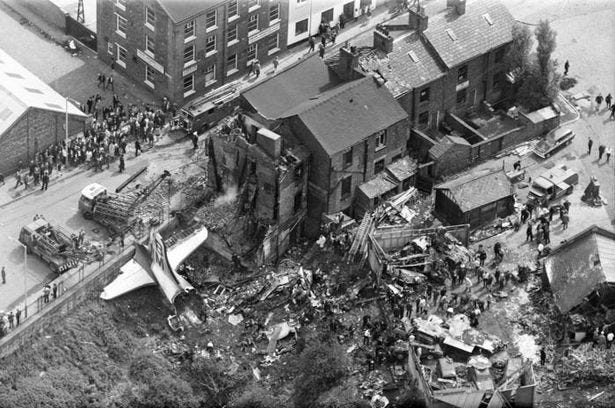
Once flight 542 broke off its initial approach to Manchester, these aerodynamic and handling characteristics meant that the crew lost any chance to reach the airport without restarting at least one of the failed engines. However, Captain Marlow couldn’t have known that when he made the decision to overshoot, and taking some time to figure out the nature of the problem must have felt more prudent. Unfortunately, by making this seemingly reasonable decision, he unwittingly steered the plane away from its only chance at a safe landing.
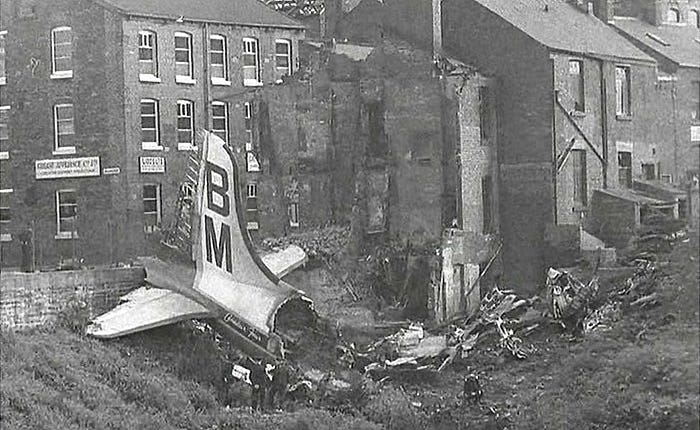
An equally important question, however, was why the engines failed in the first place, if there was nothing mechanically wrong with them. The most obvious explanation was fuel exhaustion, but records showed that flight 542 took off with more than enough fuel for the journey, and there was no evidence of a leak. Furthermore, a large amount of fuel was clearly present at the accident scene, or else the plane would not have exploded ten minutes after the crash.
This problem left investigators stumped for over four months, until pilots at other airlines revealed a bombshell: it was possible to accidentally transfer fuel between the Argonaut’s eight fuel tanks, potentially cutting off one or more engines from its fuel supply, without anyone noticing.
◊◊◊

Understanding the problem requires a deep dive into the Argonaut’s fuel system. (Readers of my earlier article on United Airlines flight 608, involving the related Douglas DC-6, may find this section familiar.) On the Argonaut, as on other similar airplanes, each engine has two fuel tanks: a main tank and an auxiliary tank. Four fuel source selector levers, located on the front of the throttle quadrant on the captain’s side, allow the pilot to switch each engine’s fuel source between the main and auxiliary tanks. On the first officer’s side of the throttle quadrant, two additional levers of identical design, called the cross feed levers, allow the pilot to run each engine off of a different engine’s fuel tank.

The cross feed system works as follows. When the right-hand cross feed lever is positioned fully forward and down, the system is off, and no cross feed occurs. When this lever is pulled back to its midpoint, a valve opens between engines three and four, allowing inter-engine cross feed. The pilot can then choose which tank belonging to engines 3 and 4 will be the source of the fuel by turning on the boost pump in that tank. For example, putting the right cross feed lever on the inter-engine position and turning on the boost pump in the number three main tank will cause fuel from this tank to flow to both engines 3 and 4.
Finally, if the cross feed levers are both pulled fully upward and aft, they will reach the “cross-ship cross feed” position, allowing a fuel tank or tanks on one wing to supply engines on the other wing. Thus, with cross-ship cross feed active and the boost pump active in (for example) the number three main tank, all four engines can be supplied from that tank.

The design of the valve which opens and closes the cross feed lines is significant. Each of the two valves — one in the right wing and one in the left — sits at the intersection of three fuel lines: one from each of the two engines on that wing, and the cross-ship line. The valve has three entry points, each separated by 60 degrees, while the other half of the circular valve has three carbon stop pads, each also separated by 60 degrees, as shown in the above diagram. By rotating the valve, it is possible to line up different entry points and carbon stop pads with different combinations of fuel lines. For example, when fully closed, two of the three fuel lines are blocked by the stop pads, meaning no cross feed can occur. Rotating the valve 60 degrees will line up two of the valve’s entry points with the lines to the two engines, allowing inter-engine cross feeding, while a stop pad continues to block the cross-ship line. However, this line too can be opened by rotating the valve another 60 degrees. The valve’s 120 degrees of motion correspond to the 80 degrees of motion of its associated cross feed lever.

As seen in this next diagram, however, the system gets tricky if the valve is slightly rotated away from the fully off position. The problem is that the carbon stop pads are the only part of the valve’s outer wall through which fuel cannot pass, and they are only slightly larger than the openings of the fuel lines which they block. Therefore, as the cross feed lever is being moved between its three positions — off, inter-engine, and cross-ship — there are numerous possible intermediate positions where fuel will flow through the valve into all three lines even if the pilot has not commanded this. In fact, fuel will flow not only into the inter-engine line but also into the cross-ship line if the cross feed lever is left any more than about ten degrees short of the fully off position, even though this arrangement is only supposed to occur when the lever is pulled a full 80 degrees upward and aft into the cross-ship cross-feed position.
In practical terms, this means that fuel will flow between the tanks all by itself if the pilot fails to push the cross feed levers all the way down into the “off” detent. If no boost pumps are on, the fuel will generally flow from the number 1 and/or number 4 tanks into the number 2 and/or number 3 tanks under the force of gravity, because the wings slope upward toward the tip. If left unchecked for long enough, this could eventually cause the fuel in outboard tanks 1 and/or 4 to entirely drain away.
But how often did this actually happen? The answer, as investigators would soon discover, was — all the time. The first problem was that from the pilots’ seats, it was not possible to tell the difference between a cross feed lever which was fully off and one which was 10 degrees short of fully off, because the levers were positioned on the front of the throttle quadrant where the pilot’s view of them was often obstructed by the throttle levers. Secondly, if the pilot was wearing their seat belt, it was very difficult to reach around far enough to be sure that the lever was in the fully off position. And third, while seated with the seat belt fastened , the captain could not reach the cross feed levers at all, nor could the first officer reach the fuel source selector levers, further hindering any attempt to verify their positions.
On top of this, pilots reported that there was no sound or increase in resistance when the cross feed levers were placed into either the fully aft or fully forward positions — only in the middle (inter-engine) position. As such, when turning the cross feed off they typically just pushed the lever as far forward as it would go, but if they didn’t quite go far enough, or if they accidentally pulled the lever slightly back up again, the cross feed valve would crack open and fuel would start flowing in unpredictable directions.
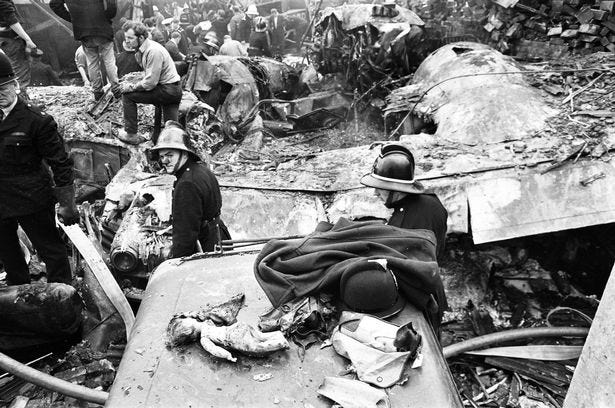
Despite the fact that the airline had been operating Argonauts since 1961, nobody at British Midland had recognized the true nature of the problem. Instances of inadvertent fuel transfer had been observed while Argonauts were parked overnight, but engineers attributed this to improper handling of the cross feed levers, and pilots universally believed that such inadvertent transfer was impossible in flight.
In reality, the engineers simply had the advantage of manipulating the levers from a more convenient angle, and without the burden of other flying duties, allowing them to more easily detect when the cross feed levers were or were not fully closed. It was not appreciated that noticing this discrepancy would be considerably more difficult in flight, nor did pilots understand that the mechanism enabling inadvertent fuel transfer between tanks was equally as applicable in the air as it was on the ground.
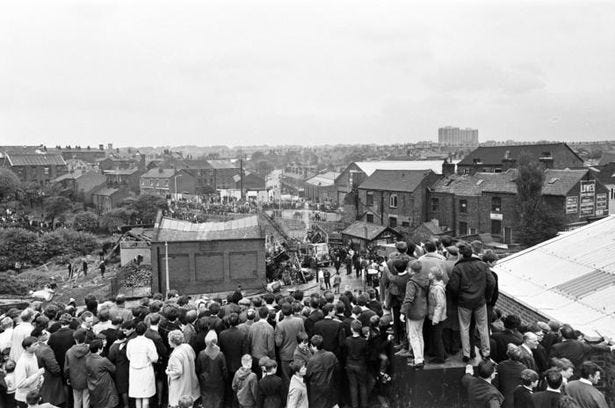
By examining fuel logs from earlier flights, investigators discovered a number of suspected incidents of inadvertent fuel transfer in flight which went unnoticed at the time. One of these cases occurred on Hotel Golf, the accident aircraft, just over five days before it crashed. On May 28th, two British Midland pilots were preparing to fly Hotel Golf from Manchester to Palma de Mallorca when the previous crew told them that the number 4 main fuel quantity indicator was significantly under-reading, while the number 3 indicator was entirely unserviceable. During the flight, the pilots noticed that this was indeed the case — in fact, about an hour away from their destination, the indicator showed that the number 4 main tank had much less fuel in it than it should, while the number 3 main fuel quantity indicator showed a value that was unreasonably high. The captain decided that this was the indication problem described by the previous crew, but the first officer wasn’t completely convinced, so he and the ground engineer decided to monitor fuel flow to the number 4 engine for any sign that it might be running low.
As the plane approached Palma de Mallorca, the first officer saw a notable drop in the fuel flow to the number 4 engine, and he immediately responded by opening the right inter-engine cross feed to supply the engine with fuel from the number 3 main tank. The airplane landed a few minutes later without incident. Afterward, the first officer and ground engineer logged the amount of fuel that had to be put back into each of the main tanks to fill them for the return journey. To their surprise, they calculated that there must have been only 14 gallons (64 liters) of fuel left in the number four main tank upon their arrival — that is, it was practically empty. However, this result was so unexpected and bizarre that the pair concluded they must have made a calculation error and decided not to report the details of the incident to the airline. Had they done so, the pilots of flight 542 might have been warned of the danger.
Considering this evidence, a plausible sequence of events aboard flight 542 began to emerge. According to fueling records, the Argonaut’s four main tanks were each filled to capacity in Mallorca, while 100 gallons (455 liters) were placed in the number 1 and number 4 auxiliary tanks. Once airborne, the pilots followed a standard sequence of fuel system configurations. During initial climb, they ran all four engines off their main tanks. Then, during the first part of the cruise phase, they ran all four engines off the two auxiliary tanks, which required opening both cross feed levers to the inter-engine position. Once these tanks ran low, the pilots would have switched all the engines back to their main tanks and closed the cross feed levers. It was at this point that at least the right cross feed lever was accidentally left a few degrees short of fully closed.
With the right cross feed valve cracked open, fuel started to flow downhill from the number 4 main tank into the number 3 main tank. Calculations based on the fuel burn logs kept by the crew of flight 542 suggested that the number 4 main tank would have entirely run out of fuel about 44 minutes before the crash. However, the number four engine did not fail at this point, nor did it show any sign of poor performance. In fact, once there was no more fuel left to flow downhill from main tank 4 to main tank 3, the pump feeding fuel to engine 4 started sucking fuel back the other way, drawing from tank 3 to keep engine 4 running.
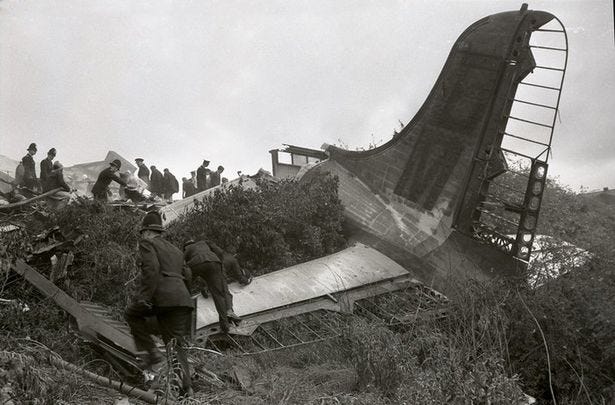
Flight 542 most likely flew in this state for over 30 minutes without anyone noticing. Although the number 4 fuel quantity indicator would have read empty, it wasn’t part of the pilots’ normal instrument scan, because the Argonaut’s fuel gauges were widely considered unreliable. Instead, pilots mostly relied on the fuel flow readings to determine whether they were burning fuel at the expected rate or not. And since fuel was still flowing to engine 4 through the cross feed from engine 3, the fuel flow gauges gave no indication of a problem, and the pilots remained blissfully unaware that one of their tanks was actually empty.
This fact only caught up with them after they had begun their descent into Manchester, when the pilots began the approach checklist. One of the items on the approach checklist was to verify that all cross feeds were closed. If First Officer Pollard followed the procedure correctly, he would have reached over and pushed on the cross feed levers to make sure they were in the fully off position. This would have finally closed the cracked open cross feed valve, cutting off the flow of fuel to engine 4, which then quit immediately.
But here the investigators faced a confounding problem: why did engine 3 also fail 15 seconds later, as must have occurred, according to the flight data recorder? In the end, they would come up with two plausible theories, neither of which could be confirmed.
The first theory went something like this. Since the fuel source selector levers had the same design as the cross feed levers, it was also possible to inadvertently crack open the valve allowing fuel to move between an engine’s main tank and its auxiliary tank in exactly the same manner as was previously described with the cross feed system. If the number three fuel source selector valve was cracked open at the same time as the right cross feed valve, fuel from both main tank 4 and main tank 3 would have flowed into the number 3 auxiliary tank, where it would have accumulated during the course of the flight. As a result, main tank 3 would have run just as low on fuel as main tank 4, and so engine 3, drawing from its main tank, also ran out of fuel as flight 542 approached Manchester. If the pilots did not discover that all the fuel in the right wing had flowed into the number 3 auxiliary tank, they would have been unable to restart either engine.
However, there were a couple of items which cast doubt on this theory, even if they couldn’t rule it out entirely. One of these was that the last entry in the flight’s fuel burn log did not show any fuel missing from the number 3 main tank, although it must be noted that this entry was made more than two hours before the crash and a lot could have changed during that time. The other problem with the theory was that it did not explain why the number 4 propeller was feathered while number 3 was not.
The second theory attempted to rectify both of these issues, but it relied to an even greater degree on speculation. According to this theory, engine 3 had plenty of fuel, but when engine 4 failed, the pilots misidentified it as engine 3. This was entirely plausible, since the Argonaut predated the introduction of engine failure warnings, and the propeller RPM gauge would have been of no use, since the Argonaut used constant-speed propellers, in which a mechanical speed governor would keep the propeller spinning at the same speed commanded by the pilots even if there was no fuel flowing to the engine. As such, the only reliable way to tell which engine had failed was to look at the fuel flow gauges. However, these were antiquated dual-pointer gauges, where one pointer showed the fuel flow to engine 4 and a second showed the fuel flow to engine 3 on the same dial, making it easy to mistake one pointer for the other at first glance. If this occurred, Captain Marlow might have shut off engine 3 and feathered its propeller, thinking that this engine was the one which had failed.
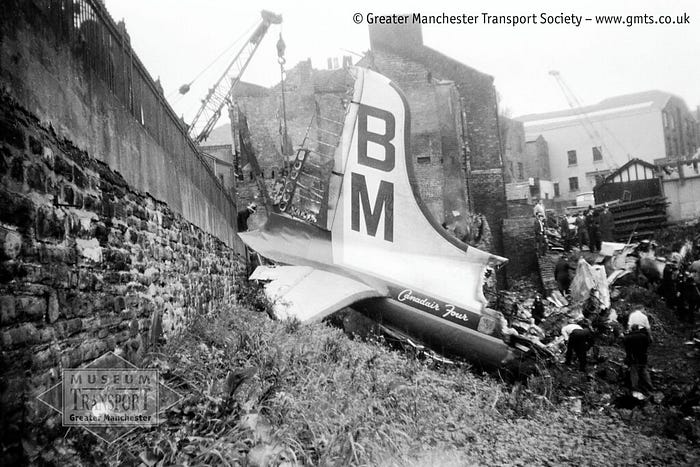
However, it would quickly have become clear to him that feathering the propeller on engine 3 to reduce drag had not improved the handling of the airplane as he would have expected (the reason being that it was actually the number 4 propeller which had been causing the drag). After struggling to keep the plane straight and level, he or his first officer might have noticed that engine 4 was the one which had actually stopped. The pilots at that point might have feathered the number 4 propeller, then unfeathered the number 3 propeller in preparation to restart that engine, only to run out of time and altitude.
In principle, the eight or nine minutes between the first engine failure and the crash should have been sufficient for the pilots to shut off the wrong engine, realize their mistake, shut off the correct engine, and start the other engine again, avoiding the accident. However, undertaking these steps would have been made considerably more difficult by the fact that Captain Marlow had to apply his full mental concentration and physical strength just to control the airplane. Carrying out the required steps would have fallen to the 21-year-old First Officer Pollard, along with literally all the other duties besides manipulating the controls, a workload that investigators felt was too high for one person. Under these circumstances, it was plausible that the pilots did not manage to restart engine 3 before the plane struck the ground.
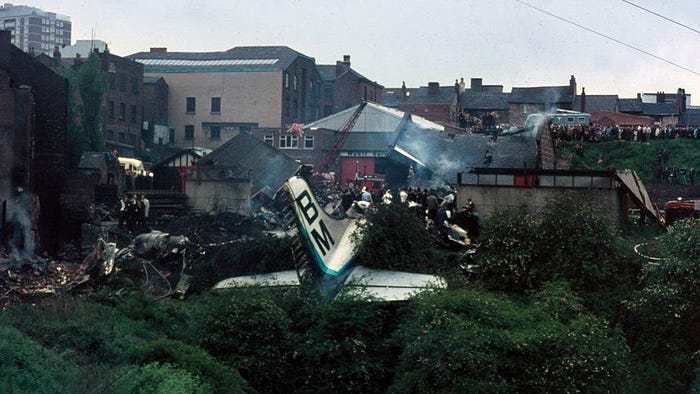
The only direct evidence for this scenario came from Captain Marlow himself, who, while under heavy sedation in hospital, had uttered the words, “Which engine was it?” This question implied that there was confusion over which engine had failed, although it was impossible to verify his intent in asking it, because he had forgotten everything by the time he came back to his senses. Otherwise, the scenario was complete speculation, as was the alternative. Unable to rule out either of the two possible explanations for the failure of engine 3, the investigators left the matter undetermined.
However, looking back from a vantage point 55 years in the future, it seems prudent to add the possible influence of pilot fatigue as a factor supporting the misidentification scenario. At the time of the accident, the pilots had been on duty for nearly 13 hours — within British duty time limits as they stood in 1967, but just outside the new set of limits which took effect in 1968, and far outside the limits which exist today. On top of that, this 13-hour shift took place overnight, and Captain Marlow had been awake continuously since 6:00 p.m. the previous day. Although investigators stated that there was no evidence the pilots were “unduly tired,” modern science has taught us that fatigue is a near certainty when working such a schedule, even if it does not manifest outwardly. As such, if the accident happened today, and if it were discovered that the pilots indeed shut off the wrong engine, fatigue would almost certainly be named as a contributing factor.
Lastly, the investigators took the time to point out some systemic problems in the aviation industry which contributed to the accident. As it turned out, even though British Midland Airways did not know of the possibility of inadvertent fuel transfer, several other current and former Argonaut/North Star operators did, including Aer Lingus, Invicta, and BOAC, the latter of which had discovered the problem clear back in 1953. BOAC had informed Canadair of the issue, and the manufacturer and operator together agreed that the best solution was simply to tell the pilots that fuel transfer could happen. However, at that time no mechanism existed by which this information could be disseminated to other Argonaut/North Star operators, and when British Midland purchased three of BOAC’s Argonauts in 1961, the knowledge was lost during the transfer.
By 1967, a system to disseminate important safety information to operators had already been created, but as a result of the crash it underwent further improvements, notably via the creation of a telephone hotline from the offices of the United Kingdom Flight Safety Committee directly to designated personnel at each UK airline.
In the end, investigators issued only one official recommendation, which was that all pilots of Argonaut/North Star, DC-4, and related aircraft with similar fuel systems be told of the possibility of inadvertent fuel transfer, both through a special notice and through incorporation of a warning into the manual. Simply knowing about the possibility and learning the symptoms was deemed sufficient to prevent a repeat accident, and indeed no similar accident ever occurred again.
The crash of British Midland flight 542 highlighted a major problem afflicting flight safety in the 1960s: the continued use of WWII-era airliners which fell far short of modern safety standards. Investigators noted that neither the Argonaut’s fuel system nor its handling characteristics with two engines out would have met 1967 aircraft certification requirements, which had changed massively from those in place when the plane was designed in 1946. That such a bizarre sequence of events could stem from a matter of a few millimeters’ difference in the positioning of a cockpit lever was an artifact of this earlier era, when the science of aircraft design was not as advanced and standards of manufacturing not as precise. These planes required extraordinary vigilance on the part of the pilots to ensure that all systems operated as they were supposed to. In light of this fact, and the role of the Argonaut’s complexity and unreliability in the pilots’ struggle to cope with the emergency, British authorities increased the model’s minimum crew requirement from two to three, adding a flight engineer.
Today, except in isolated pockets in the Arctic, these ancient piston airliners are long gone. The legacy of the crash is felt more sharply in the town of Stockport, which continues to hold memorials and commemorate the victims even 55 years later. Captain Harry Marlow, who fought so hard to save his plane, was also honored by the local community. His injuries left him unable to receive a medical clearance and he never flew again, but his deeds were not forgotten, as Stockport awarded him a medal in 2007, two years before his death in 2009. And every few years, the remaining survivors — several of them are indeed still alive today — tell their stories again to another generation. In the typically British manner, they have not let the crash haunt them. Survivor Vivienne Thornber, who nearly lost a leg in the accident, got back on a plane two years later, headed once again to a vacation in Palma de Mallorca. As if in defiance of the crash that almost killed her, she has been back another 14 times since. She may have her own reasons, but one would like to imagine that her repeated pilgrimage speaks to the vast improvements that have been made in aviation safety over the decades, as both the Stockport air disaster and the 1960s themselves continue to recede from our collective memory.
_________________________________________________________________
Join the discussion of this article on Reddit!
Visit r/admiralcloudberg to read and discuss over 200 similar articles.
You can also support me on Patreon.
